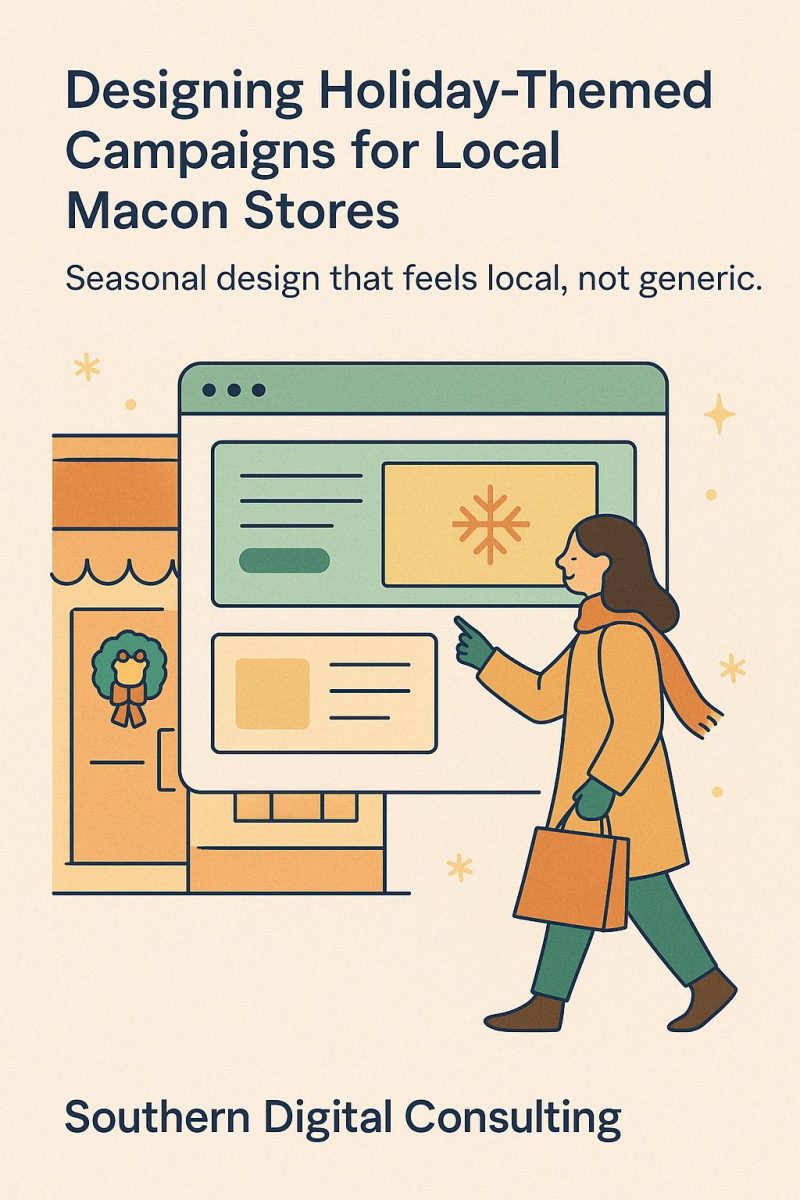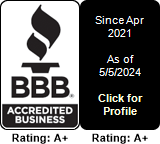In Macon, where retail still feels personal and familiar, your website needs to reflect the same seasonal rhythms people see when they drive down Riverside Drive or visit the downtown shops on a Saturday afternoon. Seasonal design isn’t about decoration. It’s about timing, tone, and recognizing what your customers are feeling when they land on your homepage. If your site looks the same in December as it did in July, you’re telling your audience that you’re not paying attention. And in a town like this, people notice. From early holiday hints in October to clearance cues in January, your visuals should shift with the mood of your buyers. This cluster explores how retailers in Macon can design sites that ride the calendar with precision, using color, layout, and content to create seasonal engagement that feels local, intentional, and right on time.
Designing Holiday-Themed Campaigns for Local Macon Stores
Seasonal design isn’t about adding snowflakes to your homepage or changing your logo colors to red and green for a few weeks. Especially not in Macon, where local shoppers expect relevance, not generic holiday noise. When the season shifts, your site has to shift with it. Not because it’s decorative, but because your customers’ expectations and shopping behaviors change right alongside the temperature. People here notice when a store updates its window displays on Mulberry Street, and they expect the same care in your digital presence. Holiday-themed campaigns that actually work start early and build momentum gradually. You don’t wait until the week of Christmas to add festive language or gift-focused categories. In Macon, seasonal shopping starts before Thanksgiving and builds week by week. That means updating your homepage banners, reworking product descriptions to reflect holiday use cases, and surfacing the kinds of collections people are actually looking for, like “Gifts under $50,” “Local Favorites,” or “Staff Picks.” Sections that signal both relevance and curation. Imagery plays a role too, but it has to feel local. Use shots of actual storefronts, real decorations, people wearing sweaters in front of familiar Macon landmarks. Not vague models in fake snow. And beyond aesthetics, structure matters. Put your seasonal offers above the fold. Add urgency with phrasing like “Holiday Orders Close Dec 18” or “Limited Stock for Local Pickup.” Use a soft nudge, not hard pressure. Make your email opt-ins seasonal as well. “Be the first to shop our gift sets” reads differently than “Sign up for our newsletter.” Use microcopy that sounds like you’re part of the town, not trying to impress one. Mention events Macon locals care about, like Bragg Jam gift bundles or seasonal pickup hours during downtown market weekends. Your site shouldn’t feel like a template. It should feel like a storefront on First Street. Warm, timely, and made for now. A good seasonal campaign doesn’t shout “it’s the holidays.” It reflects how your customers are already thinking, and it helps them act just a little faster, a little easier, and with more trust that you’re paying attention to what matters around here this time of year.
How Seasonal Colors Affect Buying Behavior in Georgia
Colors don’t just decorate your website. They shift how people feel while they browse. Especially during the holiday season, when shoppers are already emotionally primed and moving through the internet with urgency and intention. In Georgia, where seasonal cues like porch lights, church banners, and storefront decor change by mid-November, your digital palette needs to reflect that same rhythm without leaning into cliché. A retail site that carries the same neutral or clinical color set year-round misses a huge opportunity to align with buyer psychology. Warm tones like deep red, forest green, and dark gold help create a sense of tradition and comfort when layered over product displays, CTAs, or collection modules. While these tones are hardly revolutionary, what makes them work is how they’re used. Softening button edges, warming your overlay gradients, and adjusting background blocks for contrast against holiday-themed content all make it easier for someone to feel immersed in a seasonal shopping environment without ever having to name why. That emotional lift matters more than you think. Especially for local buyers who are comparing you not just to competitors online, but to businesses they walk past in Macon every day. Your colors either match the energy they’re seeing in their physical world, or they feel like they’re coming from somewhere else entirely. Buyers move faster when your site feels anchored in the moment they’re actually living in. And color is often the first and most subconscious way to establish that link. But don’t just slap on red and green everywhere and call it festive. Test how your seasonal palette affects visibility across devices. Make sure you’re not sacrificing accessibility in the name of mood. And avoid combinations that blend into themselves on smaller screens. If your “Order Now” button disappears in warm sunlight, it doesn’t matter how pretty it is. Color is one of the only design elements that hits the user instantly before they read a single word. When it’s aligned with seasonality and localized sensitivity, it becomes not just decoration. It becomes conversion support.
Timing Your Visual Updates With Macon’s Shopping Calendar
Seasonal updates don’t work if they land too early or too late. And in a place like Macon, where people actually pay attention to when the wreaths go up and when the downtown lights flip on, timing isn’t just aesthetic. It’s strategic. The typical retail site might take cues from national campaigns and start pushing holiday visuals right after Halloween. But Macon shoppers often follow a slower, more grounded pace. That means if you go full red and green before the Thanksgiving table’s even been cleared, you might feel out of sync with your audience. Start soft. Early November is the time for subtle shifts like warmer tones, early-access hints, and small banner sections that preview what’s coming without overwhelming the page. As you move toward Thanksgiving weekend, visual energy should increase. Bold hero images, product groupings tied to gifting themes, and time-sensitive overlays like “Ends Sunday at Midnight” or “Free Local Pickup Before the 23rd.” These help create movement, but also match the way Macon’s shopping culture intensifies between Black Friday and mid-December. Then, there’s the afterglow. Too many retailers leave holiday content up into January, making their sites feel neglected. You should transition visuals the day after Christmas. Move into clearance tones, light neutrals, and messaging that reflects the new year like “Start Fresh,” “What’s Next,” or “Early Savings.” Macon shoppers respond to sites that feel like they’re moving in real time with the community. That includes updates for small moments too, like downtown events, high school football finals, or Saturday markets. If your visuals never change, people assume you aren’t paying attention. And if your design stays frozen in early December when it’s already January 10th, the message is clear. This business doesn’t have its act together. Timely visuals say you’re present, in sync, and worth trusting. And that’s what drives seasonal revenue before anyone even clicks “Add to Cart.”
Year-Round Content Blocks for Seasonally Adaptive Layouts
If you have to overhaul your entire site every time the calendar flips, something’s wrong with your foundation. Smart seasonal design in Macon starts with modular layouts that flex with the time of year instead of breaking under pressure. These aren’t major redesigns. They’re small, strategic swaps—banner graphics, CTA labels, color overlays—that let your site respond to seasonal shifts without losing its core identity. Think of your homepage as a series of blocks: a hero image, a featured collection, a testimonial slider, a newsletter sign-up. Each of those can be designed once and updated quarterly with fresh messaging, seasonal photos, or time-sensitive promotions. You’re not rebuilding the car. You’re just rotating the tires. One week it’s “Fall Favorites from Local Makers,” the next it’s “Last-Minute Holiday Finds.” With modular design, you don’t need your dev team every time you want to make a seasonal change. You just need a content editor who knows how to swap components. This makes updates faster, cheaper, and more consistent. And consistency is what builds trust. Users returning in February or July shouldn’t feel like they’re walking into a different brand. The bones stay the same, but the clothing changes. That’s how seasonal design builds loyalty without exhausting your resources. Local shoppers aren’t asking for fireworks. They’re asking to feel like your site moves with them. Not just once a year, but all year long.
Promotional Banner Strategies for Macon Sales Events
Banners are the billboards of your website, but most get ignored because they’re either too generic or too aggressive. For Macon retailers, banners work best when they’re relevant, timely, and deeply tied to what’s actually happening in the community. A “Sale Ends Soon” bar with no date, no urgency, and no tie to a real event doesn’t move anyone. But a banner that says “Downtown Macon Sidewalk Sale This Saturday Only” with a clear CTA below it? That gets clicks. Placement matters too. Top-of-page is obvious, but don’t stop there. Mid-page banners between product rows or announcement strips that stick as you scroll can catch users at different stages of their journey. And remember mobile. A banner that works great on desktop might eat half the screen on a phone. Design responsive banners that shrink intelligently and still deliver the message. As for tone, ditch the hard sell. “Grab it now” doesn’t resonate like “Local favorite, limited stock.” In Macon, people respond to relevance more than pressure. Tie your banners to real-time events like First Friday, Bragg Jam, or even school breaks. When your banner feels like it knows what weekend it is, it feels alive. And that subtle sense of presence is what builds click-throughs. A good banner doesn’t just talk. It listens first.
Want a Seasonal Web Presence That Moves With Your Market?
We help Macon retailers build websites that adapt visually and strategically to what your customers are actually thinking about month to month. If you want design that flexes with Georgia’s retail rhythms, visit seasonal retail web design in Macon and let’s build something timely.



